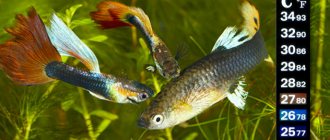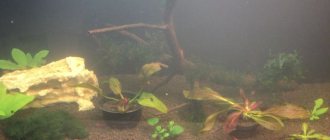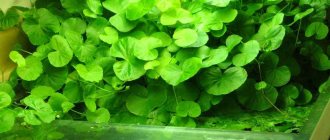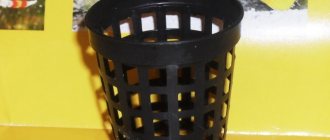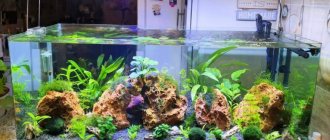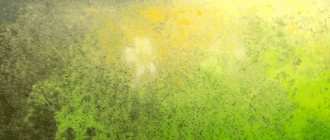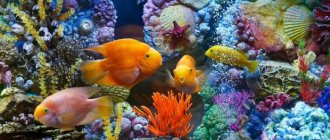An aquarium is suitable not only for keeping fish. Some may remember how once upon a time, when aquariums in the USSR were produced with unattractive iron frames, fluffy hamsters were successfully housed in them.
But no, this article is not about that. Today, the industry has made a huge step forward, decorative containers have become much more beautiful, and therefore you can create a magnificent aquarium garden yourself. The stylish composition will look no worse than the underwater landscape and will perfectly decorate the interior.
Why in an aquarium? The main reason is it's beautiful.
Modern aquariums are made of thinner glass, the seams are almost invisible. Round models are especially good in this regard. For the most part, fish are uncomfortable in them, but plants are simply wonderful. There are no drafts, the microclimate is stable, humidity is maintained without much effort.
In short, there are a lot of options for creativity.
The history of the idea of growing cacti and orchids in an enclosed space
The founder of the new fashion trend was the naturalist scientist N. Ward. The idea of keeping tropical plants in the European climate arose as a scientific necessity. The scientist’s experiments to create and maintain comfortable living conditions for heat-loving flora led not only to a passion for mini-gardens, but also to the beginning of the construction of greenhouses and greenhouses.
Ward's first boxes were made of glass plates connected by a metal frame, and resembled aquariums. Decorative gardens began to be placed in shaped glass products (bottles, retorts, etc.). Both design options became the prototype of modern florariums.
Nowadays, creating a mini-garden is a hobby for those who love beautiful indoor plants, but do not have the time to carefully care for them, providing the required temperature and humidity. In a closed space with a lamp, in an aquarium without water, it is easier to maintain comfortable conditions.
Plant selection
The compositions used in the aquarium include:
- Miniature ferns - thanks to their lace and lacy leaves, they look elegant and surprising.
- Moss vegetation will help create soil cover.
- Plaunk flowers - will create a green background and add volume.
- Orchids - will create exoticism and give a piece of the tropics. Orchids are capricious, and having organized a mini-garden with orchids (called an orchidarium), you will have to put a lot of effort into caring for it.
In open-type florariums, succulents are placed - a group of plants that absorb and store moisture:
- Agave family.
- Zamioculcas.
- Aloe.
- Cacti.
- Haworthia.
- Rejuvenated.
What is a florarium
The concept of a florarium can include any transparent container in which plants are planted. Depending on their variety and requirements for special conditions, all types of florariums can be divided into dry and wet.
The first contain cacti and succulents, which require minimal air and soil humidity. In structures of the second type you can find orchids and semi-aquatic or marsh plants that require high temperature and humidity.
In addition, the florarium can be:
- floor, wall or hanging;
- big and very small;
- open and closed;
- have lighting and heating equipment or not.
Modern florariums are made not only of glass, but also of transparent plastic.
The main content of the florarium is live plants. But sometimes the composition includes additional decor from natural materials (for example, unusual soil or expressive stones, shells, driftwood, etc.). The vessel itself can be decorative: a vase, glass or a specially made container of a bizarre shape.
Succulents in an aquarium
The most popular plants for florariums are succulents. They are easy to grow and do not require special care or conditions. Succulents have bright, dense leaves and succulent stems. There are many varieties of succulents, so you can always choose an interesting option for your florarium.
The most common types:
- Zamioculcas: a slow-growing plant that is grown in an outdoor florarium;
- piketail: a beautiful plant with large green leaves and yellow stripes;
- Kalanchoe;
- haurotia;
- stone rose;
- aloe.
Succulents will bring a bright tropical flavor to the florarium, making it unique.
Which plants are suitable for growing behind glass?
Its spectacular appearance depends on the correct choice of inhabitants of a plant terrarium. In a composition of several specimens, you can include contrasting plants (with different heights or colors). Sometimes a florarium is decorated with only one accent bush, and the rest serves only as a background (for example, a mini violet on a moss cushion). In the rocky interior, the mountain landscape will be recreated by succulents, and miniature water lilies (tiger lotus, etc.) will complement the open mini-pond in the room.
The main criterion for selecting plants is a size of no more than 20 cm and a low growth rate. Representatives of large-leaved species in a small container will look crushed and crushed, and fast-growing flora will have to be replanted frequently.
Cacti are suitable for growing behind glass.
Best filling options:
- cacti and succulents;
- mosses and selaginella;
- small representatives of ferns (pteris, asplenium, etc.);
- mini violets;
- lithops;
- fittonia, etc.
Plants are selected so that 50% of the volume of the vessel remains unfilled.
Succulents in an aquarium
Succulent plants (agave, zamioculcas, aloe, sansevieria, haworthia, etc.) are the best option for filling a mini-garden. From them you can create compositions with a hint of semi-desert and mountain landscapes, fantasy landscapes, a piece of tropical forest, etc.
A feature of succulent plants is their undemanding nature when it comes to watering. By accumulating moisture in succulent stems and leaves, they do not suffer from the forgetfulness of their owners and do not lose their spectacular appearance. In unfavorable conditions, plants enter periods of dormancy, stopping their growing season. This property can be used to regulate the growth of a number of succulents (for example, Kalanchoe).
What is an aquarium with flowers
An aquarium with flowers is called a florarium. This is a familiar glass tank, but instead of fish and algae, flowers are grown. These are small flowering plants, dwarf representatives that cannot be grown at home on a windowsill. A favorable ecosystem for growing vegetation is created in the reservoir, and then all that remains is to maintain the microclimate and monitor growth.
In a small apartment, a DIY flower aquarium will take its place. An aquarium garden is an excellent alternative to a greenhouse if there is not enough space. It creates a favorable environment for vegetation, and tropical or rare flowers grow at home.
Execution options
There are 2 options available for self-production:
- closed - in a container with high walls and a lid (garden in a bottle);
- open - collected in a container where the composition is located above its walls (for example, in a flat vase).
For which plants is a sealed container suitable, and for which – an open container?
Sealed vessel with plants.
Specimens that require high air humidity can be planted in an airtight container. During aspiration and evaporation from the soil in a closed jar, a microclimate is quickly formed, which is necessary for a number of indoor flowers.
It is better to choose representatives of the flora that rarely lose leaves and grow slowly, because to remove excess you will have to open the box and lose moisture.
If a sealed florarium is placed in a bottle or container with a narrow neck, then any maintenance will be difficult.
In addition to moisture-loving flowers, it is convenient to place cacti and succulents in airtight flasks. They require minimal intervention during growth, and minor aspiration does not increase the humidity in the vessel. Watering is rare, and a sealed mini-garden does not cause any trouble to the owner.
For open compositions, specimens are selected that can normally withstand room conditions (temperature +25°C, low humidity, etc.). These include the same succulents, ferns, selaginella, different varieties of fittonia (with unusual foliage color), small begonias, etc. Tree crops formed according to the bonsai principle can also be included in the mini-garden.
Storage for fragile items
In every home there are things for whose safety we are especially worried. If you have art at home that you would like to keep intact, simply place it inside an empty aquarium.
You are unlikely to want to throw away your old aquarium, because now you know how many unusual and original things can be made from things that seem unnecessary at first glance.
Is your life full of stress and worries? Do you suffer from insomnia and high blood pressure? So, you just need to have an aquarium at home!
Scientific studies have shown that watching fish can help lower blood pressure, reduce stress and make you feel more relaxed.
In addition to the health benefits, a properly designed aquarium can look great in your home and attract a lot of attention from guests.
For example, choose an aquarium from today’s selection and imagine it in your home. Like? Then what are you waiting for? The only thing you should think about before starting an aquarium is the need to adapt it to living conditions suitable for the fish you have chosen.
1. Balancing aquarium
We are scared to look at this aquarium, but its creators swear that the fish is not in any danger: the design of the aquarium is based on the principle of counterweight, and the balance between both parts is calculated more than well. Well, let's hope so.
2. One vessel, two lives
For lovers of both fauna and flora: an aquarium and a flower pot connected together.
3. Air aquarium
The unusual design gives us only one thought: how has this fish not hanged itself out of boredom?
4. Aquarium in the form of an iPod
This aquarium combines a small player and the same miniature aquarium: a single fish can live in it, since the capacity is slightly more than half a liter of water.
Unfortunately, this aquarium is also poorly suited for fish life, because, as practice has shown, with such a small volume, the fish simply do not have enough oxygen to support life.
5. Aquarium Sink
This aquarium will allow you to enjoy the sight of fish while you relax in the bath.
Double portion of pleasure! The top glass lifts up, making the aquarium fairly easy to clean and maintain. 6. Aquarium vase
These jars can be easily separated from the top of the shelf, so you can change the water in them and feed the fish.
There are holes in the top of the jar that allow sufficient oxygen to pass through. However, the creators do not explain how to handle the heating and filtration of such an aquarium. 7. Mountain design
A variation of the classic round aquarium: the only difference is that in the middle of this aquarium there is a glass mountain around which a fish swims.
8. Telephone Booth Aquarium
Benoit Desel and Benedetto Bufalino transformed an ordinary telephone booth into a real, functioning aquarium for the Festival of Lights in Lyon, France.
9. Aquarium table
This table is a real find for both lovers of aesthetics and practical people.
Thanks to the special composition of the cover glass, it does not scratch and objects that you place on top will not disturb the fish. 10. Tube aquarium 11. Aquarium office desk 12. Portable aquarium
13. Aquarium from an old TV 14. Aquarium-sofa 15. Aquarium-vases 16. Aquarium-labyrinth
17. Hanging aquarium
18. Endless aquarium
The garden (outdoor) aquarium came to us from Japan and Central Asia.
This is a small artificial reservoir of regular geometric shape, raised above the ground and stylized as an aquarium. With its own ecosystem. That is, it is not enough to create the aquarium itself, you will also need to populate it with fish and plants that require constant care and attention, and create a certain landscape in it. But more on that later.
Where to put the florarium
The choice of location for a garden behind glass depends on the type of plants. This is especially carefully taken into account when cultivating flowers in a closed container: the temperature inside can rise to critical levels if the container is left in the sun. The best place is next to a window that receives the sun only a few hours a day.
A small decorative vessel can be conveniently placed on a desktop or bookshelf. If you have containers of different sizes, then when you decorate them in the same style, you can create a large composition by placing all the containers on a rack.
Garden aquarium parameters
Of course, an outdoor aquarium differs from an apartment one both in the size of the bowl and the dimensions of the inhabitants. The area of the most popular garden models is up to 15 sq.m., depth is from 1.2 m to 3 m. The design itself is also more complex. Since childhood, we have become accustomed to the fact that it must stand on something: on a bedside table, shelf and other “pedestals.” Later, models appeared that were built into a wall or cabinet. A garden aquarium can either stand alone (on a pedestal) or be located in a recess. Which, in turn, must be fenced with walls made of concrete blocks or bricks.
What to consider when building an outdoor aquarium:
1. It must have a clearly defined geometric shape
: square, circle, rectangle. Compare with an ordinary garden pond: you can choose any configuration of the pit for it, including those that do not have a clear geometry. This is unacceptable for aquariums.
Interesting:
Street models
of simple rectangular shape
(cube, parallelepiped) are in particular demand:
- Firstly, it is easier to apply waterproofing to it.
- Secondly, less dirt settles on the vertical walls, which greatly simplifies the maintenance of the structure.
2. Availability of “points/observation points”
. To prevent the aquarium from becoming a concrete box without a specific purpose, one or more of its walls are made of durable glass. Through them you can admire his “inner” life.
Interesting:
There are also garden aquariums without glass walls, where you can watch the fish from above. Such options are easy to make yourself, without much effort and the involvement of craftsmen.
3. The bottom of the structure must have a conical slope
so that the drain can be placed.
4. The structure must be equipped with water filters
and other systems that support the life of fish and plants.
5. The aquarium must have a place for fish to feed.
. Even if you don't plan to breed them yet, think about the future. It is better to do it in advance so as not to redo the entire structure later.
Important:
No matter how large a garden aquarium is, it is not intended for swimming or fishing. This is a purely decorative item.
List of suitable containers and materials for decoration
The vase is multifaceted.
The following are suitable containers for a garden behind glass:
- round glass aquariums;
- frameless rectangular home ponds made of glass or plastic;
- multifaceted geometric vases (assembled independently using patterns);
- bottles and glass jars of unusual shape, with and without corks;
- glasses, glasses, teapots with a transparent body, vases without decoration;
- opaque ceramic and glass flat vases, candy bowls, etc. (for open and water compositions);
- laboratory glassware;
- Christmas balls and incandescent lamps.
For the first experiment, a sealed plastic container with transparent walls or a glass vase is suitable.
In addition to plants, the composition can include:
- tree branches or driftwood on which it is convenient to attach moss;
- stones and shells, lava flows (sold in aquarium departments);
- models of buildings, figurines of animals or insects, pearls and pieces of coral (for a seascape);
- pine cones, dried flowers and other natural material.
Landscaping a garden aquarium
The ecosystem inside a garden aquarium is organized at the discretion of the owners: you can populate it with fish and plants, or you can stop only with landscaping.
In the latter case, you will get a planted aquarium. To fill it, ordinary garden soil or soil taken from the bottom of a reservoir is quite suitable. The following will feel good in the middle zone:
- urut,
- elodea,
- egeria,
- hornwort,
- Vallisneria and others.
By and large, they are adapted to the open waters of our latitudes.
Such amphibious plants decorate the surface of the water and serve as a kind of filter for water, purifying it and saturating it with oxygen. If your aquarium is of a more “advanced” level and is equipped with systems for maintaining heat and oxygen balance, then you can plant more capricious plants in it. They are very beautiful, but require certain maintenance conditions, since tropical waters are considered their homeland. Such plants include:
- Echinodorus Schlüter,
- azolla carolina,
- hydrilla and others.
An aquarium cannot be complete without Azolla, Pistia, Vodokras and other plants that “float” on the surface of the water and create shade.
If the size of the aquarium allows, then egg capsules will not be superfluous. Caring for aquarium flora is not difficult: there is no need to water or weed anything, except perhaps feed it. For this, it is permissible to use garden ones, which every summer resident probably has.
Important:
Feeding is carried out only in exclusively planted aquariums, without fish.
We create a florarium with our own hands
The most difficult thing is to make miniature compositions in a bottle or lamp, but decorating a medium-sized vessel is not difficult even at the first try. For beginners, it is best to choose succulents, small cacti, selaginella, juveniles and similar varieties of flora. When planting, you need to take into account that you will have to occasionally water the plants and provide access to each bush.
In an aquarium or round vessel
Round container for indoor plants.
The standard 10 liter round aquarium is an impressive glass container for the home garden. You can place it with the hole facing up or rotate it so that it is on the side.
The dimensions of the glass bubble allow you to plant quite large types of indoor flowers in it:
- 1-2 bushes of Saintpaulia or saxifrage, Fittonia, small peperomia, etc., similar in size;
- several different succulents up to 15-20 cm high;
- cacti with a decorative appearance or beautifully flowering ones (mammillaria, rhipsalis, echinopsis, etc.).
4-5 cm of drainage (pebbles, PGS) is poured onto the bottom of the vessel, and a layer of activated carbon is placed on top (the tablets do not need to be crushed).
It is most convenient to buy soil with nutritional properties ready-made (especially for orchids, cacti or other demanding plants). Before laying, the soil is moistened and loaded into the prepared aquarium, creating terraces or hills.
After this, they move on to planting plants. In a 10-liter aquarium, this can be done by hand, since the opening is large enough. The bushes are planted in the traditional way, placing the roots in the hole, covering them with soil and compacting it.
When creating a composition, they are guided by the compatibility of plants: you can plant tall and low species, creating axes according to the ikebana principle, supplement the orchid with moss or ground cover grasses, etc. After planting the flowers, water and decorate the surface, covering the soil with a layer of river sand or pebbles.
In a small vessel (for example, a flask from a teapot), the easiest way is to place a pot with a rosette of agave or young, and then cover it with pebbles. They do the same with cacti or succulents, selaginella, etc.
In a large tall jar for beginners
Even a simple three-liter glass jar can serve as a container for a plant terrarium. Taking into account the elongated shape, the selection of colors for the composition is carried out so that there is no empty space left at the top.
Houseplants in a jar.
A good accent is Sansevieria (pike tail), with green leaves or leaves edged with a yellow stripe. It is advisable to plant only one tall plant, and you should not use options with a pronounced trunk and a head of foliage for this: the jar narrows slightly at the top, and the lush crown will create a feeling of cramping.
Under the plant that forms the vertical axis, several small ones are placed, filling the middle part of the jar. Here you can already plant a fat plant formed in the form of a tree or a rosette with leaves on long petioles (ferns, small aroids, etc.).
At the bottom there are low bushes such as fittonias, violets, and saxifrage. It will be beautiful if you cover the soil with a lush cushion of moss or selaginella. The selection of herbs depends on the landscape being created.
Semi-desert succulent in a candy bowl
A candy bowl in the shape of a large wine glass is a good replacement for an aquarium. It is slightly smaller in size, has a comfortable leg and a wide opening. For an open semi-desert landscape, a wide candy bowl of small depth is also convenient.
Compositions are arranged in different ways:
- Wine glass vase. The landscape is collected according to the principles described for the aquarium. It is important to provide a thick layer of drainage (at least 4 cm) and put activated carbon on it (it absorbs some of the harmful substances from the soil). For a desert landscape you will need fine sand, stone fragments and other appropriate decor. To prevent the landscape from looking flat, some herbs can be placed in containers, raising them above the ground. If the vase is large enough, plant several small or 2-3 large bushes. A single colorful agave or aloe bush will look beautiful in a small container.
- Wide vase. An open desert landscape can be flat, creating the illusion of more space. If you want to make it hilly, it is better to place the hill closer to the central part, since the composition has no walls. When planting plants, you can create a false perspective by planting larger bushes in the foreground and smaller ones in the background. The planting method remains the same: the drainage layer does not allow the roots to become sour and, if necessary, supplies the soil with moisture.
Geometric garden
The peculiarity of a geometric vessel is its many flat edges. They do not allow you to perceive the composition as a whole, so it is worth planting plants so that they look beautiful when viewed from different angles.
Garden in a geometric vessel.
The planting technique does not differ from other closed-type options; the only difference is in linking the shape of the composition to the contours of the vessel. In the highest places, pots with plants stretched upward are planted or placed; low-growing flowers (for example, antimime, sedum) are placed on the side of the small edges.
The simple shape of a triangular pyramid will be successfully emphasized by a tall central element (sansevieria, dracaena, calamus) and low grasses harmoniously placed around it. As each face approaches the foreground, the height of the plant is reduced.
If the shape of the vessel is more complex, the slope of the edge is taken into account when planting, and the highest element is placed closer to the highest point of the structure.
Microworld in a light bulb
The main difficulty in this work lies in the impossibility of planting plants by hand. You will have to work with long tweezers.
In addition to this necessary tool, prepare:
- incandescent lamp;
- pliers;
- screwdriver;
- scissors.
It is advisable to protect your eyes with glasses.
The lamp is disassembled as follows:
- crumble the dark mass on the base of the base with pliers;
- use a screwdriver to push out the glass rod and pull it out with tweezers;
- remove fragments of the spiral and other parts, completely emptying the flask of its contents.
Through the hole in the base you can place both soil and plants inside. Before this, you need to determine how the lamp will stand on the table and attach a stand to the bottom. It is convenient to use a ring from narrow adhesive tape or a similar element of another origin. The stand is secured with superglue.
There is a microcosm in the light bulb.
Prepare the sand: wash it, calcinate it and cool it. Pour the substrate inside the lamp, forming a layer at your own discretion. Cacti, succulents, antimime and moss are used for filling. The size of the plants is selected so that they fit into the hole in the base. The bush is clamped with tweezers, carried into the flask with the roots first and buried in the sand. Pieces of moss cushion are placed in selected places.
After planting, the plants need to be watered using a plastic bottle with a cocktail straw attached to the lid. Moss is moistened from above.
You won’t have to water and feed too often: the closed flask retains moisture for a long time, and the condensation supplies the roots with water. The watering time is determined by the decrease or complete disappearance of effusion on the flask.
How to care for the composition?
Caring for an oasis inside a glass flask is not very difficult. Standard rules include the following:
- As when caring for any living plants, we must not forget about watering in accordance with their preferences (after all, plants that love moisture and do not need frequent watering are planted in florariums). It is also necessary to loosen the soil and spray if this is required by the flowers growing in the flask.
- For completely closed florariums, it is necessary to select special plants that can grow well in an isolated space. Many capricious, difficult-to-care representatives of the flora cannot stand this and die, so it is necessary to determine the nuances of caring for the flower in advance.
- Large florariums require an automatic watering system that will help maintain the microclimate inside the flask.
- When creating your own composition, you cannot use antagonistic plants: for example, shade-loving and light-loving. In this case, one of them will definitely die.
- For each florarium, it is necessary to select a temperature regime and ensure sufficient lighting. For some difficult-to-care plants, you will need to think about additional lighting - for example, a phyto-lamp.
- The plants will grow larger, and they may begin to run out of space in the flask. To prevent this from happening, care must be taken to trim or pinch the shoots in a timely manner.
- If the leaves of the plants begin to turn yellow, you should apply a suitable fertilizer in the minimum possible concentration - after all, the size of the flask and the volume of soil are usually insignificant, so an excess of fertilizing can destroy the inhabitants of the florarium.
It is important to remember that a florarium composition lasts an average of 2 years, after which the plants should be replanted and a new small masterpiece created inside the flask.
If you don’t have time to care for the florarium or have doubts about your own abilities, you can always choose either a closed or semi-closed eco-system (it does not require watering at all or needs it every few months). A florarium with artificial plants would also be an excellent option. If you choose high-quality source materials (artificial succulents look especially realistic, stabilized moss is effective), then such a small oasis will not take any time at all, but will look like a bright green corner in an apartment or house.

